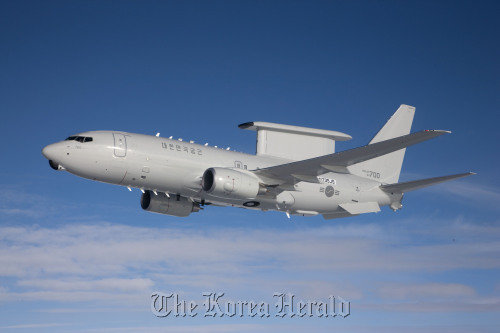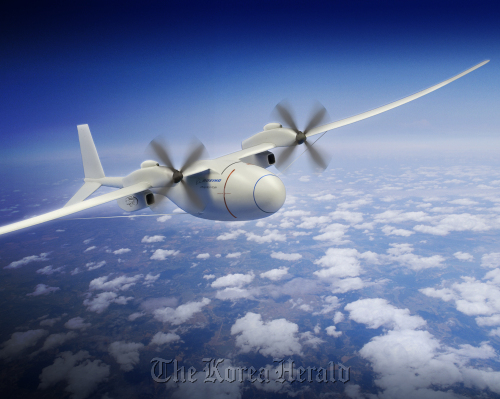SEATTLE ― The capability to glean crucial intelligence on potential enemies and quickly detect any signs of possible aggression from them is indisputably the most critical requirement to ensure national security.
To meet this, the U.S. aerospace giant Boeing has been working on developing a set of state-of-the-art intelligence, surveillance and reconnaissance aircraft, both manned and unmanned.
One of them is a 737 early warning and control aircraft. South Korea is expected to receive the first of four AEW&C aircraft ― also known as the “Peace Eye” ― in June, according to Boeing officials.
To meet this, the U.S. aerospace giant Boeing has been working on developing a set of state-of-the-art intelligence, surveillance and reconnaissance aircraft, both manned and unmanned.
One of them is a 737 early warning and control aircraft. South Korea is expected to receive the first of four AEW&C aircraft ― also known as the “Peace Eye” ― in June, according to Boeing officials.

Seoul signed a $1.6 billion contract in November 2006 to introduce the four by 2012. Boeing’s services for the contract also include ground support segments for flight and mission crew training, mission support, and aircraft and system modification support.
The Peace Eye aircraft is expected to play a significant role in South Korea’s intelligence and reconnaissance activities, particularly at a time it is preparing to retrieve wartime operational control from Washington in December 2015.
The high-tech platform, designed to detect objects in the air and at sea, include Northrop Grumman’s Multi-mode Electronically Scanned Array radar and identification friend or foe system; electronic support and communications measures; and electronic warning and self-protection system.
South Korea believes the four Peace Eye aircraft it will introduce can cover key areas on the peninsula around the clock. One aircraft is to operate for about eight hours and then touch down for crewmembers to rest, officials explained.
“If we have an in-flight tanker, we can conduct our operations more efficiently and longer. As we are currently focusing on situations concerning North Korea, the four aircraft can cover key peninsular areas,” a military official said on condition of anonymity.
The Peace Eye plane to fly with a top speed of 340 knots is to offer all-weather surveillance, command-and-control, and a communications platform to guide fighter-interceptors and tactical air force aircraft to combat areas.
“The AEW&C plane operating at an altitude of 3,000-4,000 feet is hardly affected by adverse weather while it may be affected by weather while taking off or landing,” the official said.
To reduce the fatigue of crewmembers, the plane is designed to have less noise than other military aircraft and each seat is adjustable to make the crew feel comfortable, Boeing officials said.
The first AEW&C aircraft for South Korea is currently undergoing a mission system flight test program in Seattle, Washington. Three other Peace Eye aircraft are being modified by Korea Aerospace Industries in Sacheon, Korea, and will be delivered by 2012.
Boeing has also been working on developing an unmanned intelligence-gathering aerial vehicle, called the “Phantom Eye.”
The Phantom Eye is a hydrogen-powered high altitude long endurance aerial vehicle system for intelligence, surveillance, reconnaissance and communications.

It can fly at an altitude of 65,000 feet with a maximum speed of 200 knots.
The Phantom Eye demonstrator has an advanced propulsion system that enables the aircraft to carry out monitoring missions over large areas for up to four days while carrying a 450-pound payload.
Boeing is also working on a larger HALE system that will stay afloat for 10 days and carry payloads of more than 2,000 pounds. Typical payloads include multiple sensor packages for monitoring and tracking mission roles.
By Song Sang-ho (sshluck@heraldcorp.com)
(Korea Herald correspondent)


![[AtoZ into Korean mind] Humor in Korea: Navigating the line between what's funny and not](http://res.heraldm.com/phpwas/restmb_idxmake.php?idx=644&simg=/content/image/2024/04/22/20240422050642_0.jpg&u=)


![[Exclusive] Korean military set to ban iPhones over 'security' concerns](http://res.heraldm.com/phpwas/restmb_idxmake.php?idx=644&simg=/content/image/2024/04/23/20240423050599_0.jpg&u=20240423183955)
![[Herald Interview] Why Toss invited hackers to penetrate its system](http://res.heraldm.com/phpwas/restmb_idxmake.php?idx=644&simg=/content/image/2024/04/22/20240422050569_0.jpg&u=20240422150649)
![[Graphic News] 77% of young Koreans still financially dependent](http://res.heraldm.com/phpwas/restmb_idxmake.php?idx=644&simg=/content/image/2024/04/22/20240422050762_0.gif&u=)






![[Exclusive] Korean military to ban iPhones over security issues](http://res.heraldm.com/phpwas/restmb_idxmake.php?idx=652&simg=/content/image/2024/04/23/20240423050599_0.jpg&u=20240423183955)



![[Today’s K-pop] Ateez confirms US tour details](http://res.heraldm.com/phpwas/restmb_idxmake.php?idx=642&simg=/content/image/2024/04/23/20240423050700_0.jpg&u=)